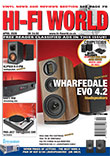Page 2 of 3
Cartridge weight is a light 6.1gms with stylus carrier in place, a figure all arms can cope with. Also available are the entire range pre-fitted to a high quality, rigid Audio Technica AT-HS6BK head shell. Audio Technica told me the VM95 body has a simpler generator assembly comprising two coils (left and right channel) with no magnetic screen between them; the more expensive VM700s have four coils, plus screen. Also, they have a cast aluminium body and better (tapered) cantilevers. That’s five tips covered. Number six, the VM95SP price £69 (stylus £55) I could not assess: it is a 3mil tip for 78s. We have none! Audio Technica usefully explain that life expectancy is 500 hours for conical, 300 hours for elliptical, 800 hours for Shibata and 1000 hours for Microlinear. Tracking force is 2gms nominal for all tips except that for 78s. Fitting the stylus isn’t so easy; it is plugged in from below with stylus guard on and I found it difficult to locate; afterward the guard is slid off forward. All stylus assemblies use an aluminium tube cantilever, with two miniature magnets bonded on in 90 degree V arrangement. The connection pins lack colour coding – a surprise since the uninitiated need this convenience.
SOUND QUALITY Our supplied cartridge body was fitted to an SME309 arm, mounted on a Timestep Evo modified Technics SL-1210 Mk2 turntable. This fed an Icon Audio PS3 Mk2 valve phono stage and Icon Audio Stereo 30SE single-ended valve amplifier driving Martin Logan ESL-X hybrid electrostatic loudspeakers. The system was supplied by an Isotek Evo3 Mosaic Genesis regenerated power supply to eliminate mains distortion. Stylus assemblies were fitted to the body. With five styli and five high quality test LPs (all 180gm, some 45rpm), plus additional ’normal’ LPs, the subjective results below are inevitably a distillation. At heart the VM95 range is based on a budget cartridge, the cheapest VM95C and this largely determines overall character. As measurement shows, all VM95s are forward in the midrange, fairly cool in their sound as a result – not dull – and quite revealing.
At left is the conical stylus of the AT-VM95C (blue) on a round shank. At right is the AT-VM95SP 78 rpm stylus – larger for wider grooves.
The better tips progressively improve high frequency retrieval and imaging, especially on inner grooves, but they don’t alter basic presentation: look to tapered aluminium pipe cantilevers of AT’s more expensive moving magnets (AT530 upward) for a punchier and less bland lower midrange.
The VM95ML Microlinear gave a reasonably bright tonal balance with delicious retrieval of fine high frequency detail that came across with firm confidence. With Stevie Ray Vaughan’s Couldn’t Stand the Weather (45rpm LP 180gm re-master) his guitar strings cut out with speed, there was no muddle when the mix got complex. This quality remained right through to inner grooves where on Time to Say Goodbye (Two Countries One Heart, 180gm, 33rpm) singers Cheryl Porter and Roselle Caporale were kept well apart, as only this tip and the Shibata could do. The VM95SH Shibata tip was slightly darker in its sound than the ML yet smooth and detailed up top, again with wonderful separation of instruments. With Fanfare for the Common Man (Two Countries One heart, 180gm, 33rpm) horns were more dense and sonorous than from the ML, kettle drum a tad more powerful. The SH is as capable as the ML but less brightly lit and arguably preferable, but not always: Jackie Leven’s The Wanderer on inner groves fared best with the ML.
The VM95 stylus assembly has a locating spigot that guides it into the body; it's fitted from below.
The VM95EN nude elliptical had plenty of body and drive with Alison Goldfrap’s Lovely to CU, making the ripping synth sound big and meaty. There was some softening of images across the sound stage and a de-focussed effect was apparent, especially on inner grooves with the Trondheim Soloists behind Marianne Thorsen; here the ML and SH kept them all well separated but the EN introduced blur. All the same the ‘95EN survived all the test LPs and gave a lively sound with good tonal balance. I expected the VM95E/H and VM95C to mistrack kettle drum in Fanfare for the Common Man, since the outer groove is cut at high level, but they sailed through, delivering enormous drum strikes. The C was rather humdrum and diffuse in its sound generally, but not inaccurate. The E/H managed better than I expected with more punch and life than the C, but some coarseness and muddle in treble when the going got tough. Going back to overall sound quality, rather than that due to tip differences, all five units have a light yet easy sound with a slightly bland lower midrange compared to Audio Technica’s VM750SH I use as a reference moving magnet (MM) cartridge, or especially the powerful bass from an Ortofon Cadenza MC. Best not to get too distracted by the fancy tip profiles; at heart this is a budget range. However, with our top quality 180gm re-masters – especially those spinning at 45rpm – in absolute terms quality was extraordinary – more fluid and dynamic than CD. So I was completely impressed and enjoyed reviewing all five.
|
Search
Hi-Fi World, Powered by Joomla!; Hosted by Joomla Wired.






